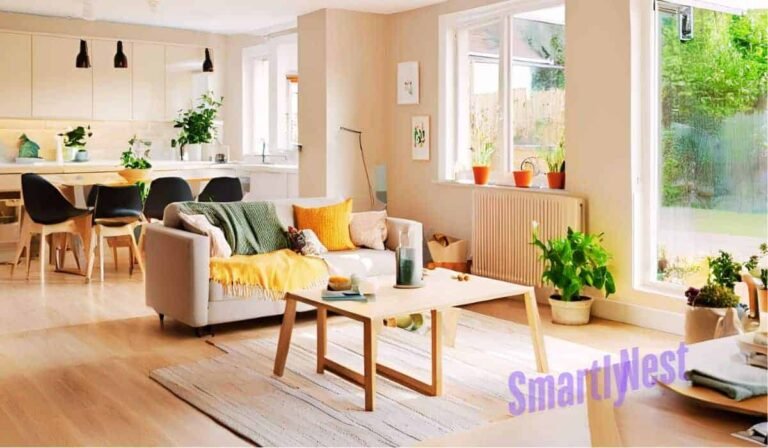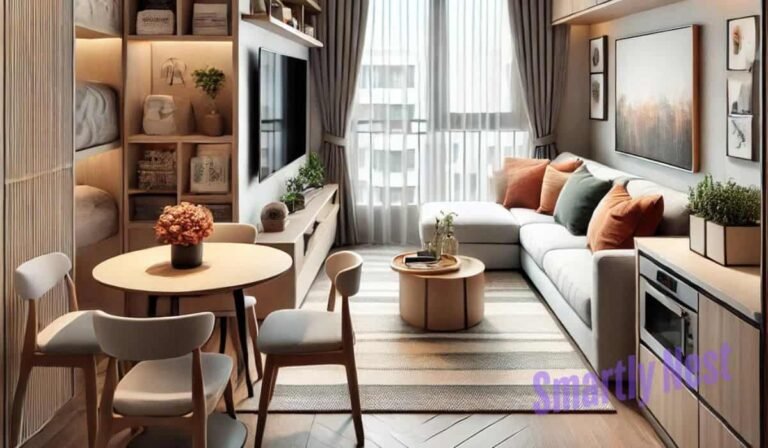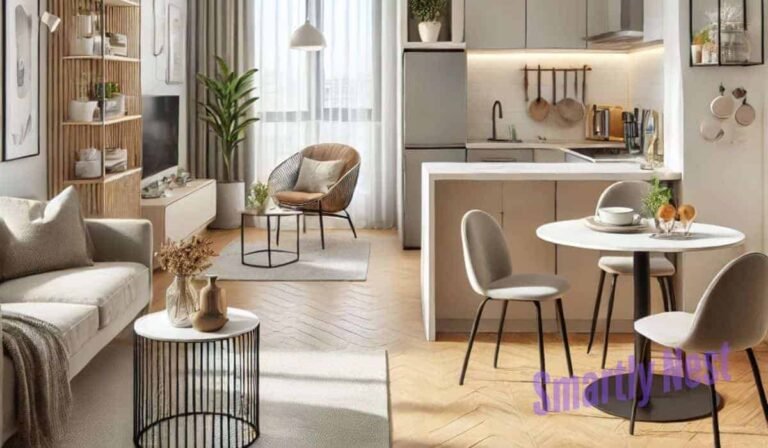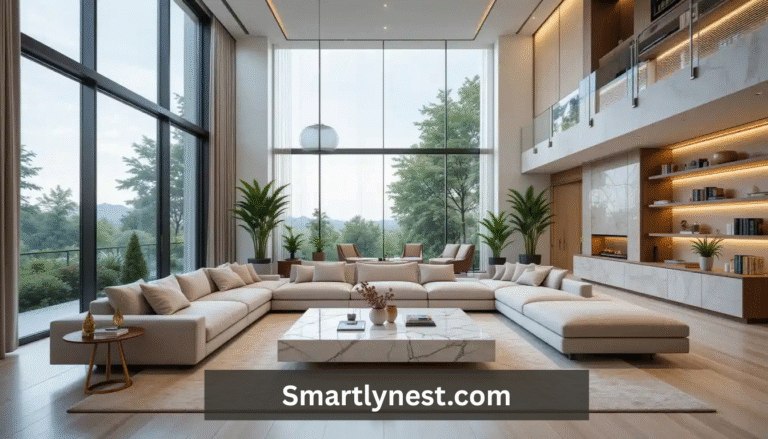
In today’s world, especially in urban areas, small living spaces are becoming the norm rather than the exception. Combining your living and dining areas into one compact room can be both practical and stylish, but it requires some creative thinking. The challenge lies in making the most of every square inch while ensuring that the space remains functional, comfortable, and visually appealing.
Fortunately, there are plenty of smart layout ideas that can help you achieve just that. Whether you’re living in a studio apartment or have a modestly sized home, these 25 ingenious ideas will guide you on how to create a beautiful, efficient living-dining space that you’ll love to spend time in.
1. Open Concept Layout
Remove Unnecessary Walls for Seamless Flow
One of the most effective ways to maximize a small living-dining space is to eliminate any unnecessary barriers. If you’re lucky enough to have the flexibility to redesign your space, consider removing walls or partitions that separate the two areas. An open concept layout helps to create a seamless flow and makes the entire space feel more expansive.
By keeping the walls open, you not only improve airflow and natural light but also create an environment where the living and dining areas visually merge, making the space feel bigger than it is.
Consistent Flooring for Cohesion
Opt for one type of flooring across both areas to unify the space. Whether it’s hardwood, tile, or polished concrete, a consistent flooring material helps to visually connect the living and dining zones, contributing to a more cohesive and spacious atmosphere.
2. Zoned with Area Rugs
Define Areas with Rugs
Area rugs can serve as excellent tools for defining different zones within a room. For a living-dining space, you can place a rug under the dining table and another in the living area to visually distinguish each zone.
Complementary Colors for Harmony
Choosing rugs in complementary colors ensures that the space maintains a cohesive feel while still highlighting the individual functions of each area. For example, choose soft neutral shades for both rugs or match colors to your overall design palette.
3. L-Shaped Layout
Utilize Corner Space Effectively
An L-shaped layout is ideal for smaller spaces as it allows you to make the most of corner areas. Position the dining table along one wall and place the sofa at a right angle, forming a functional and cozy seating arrangement.
This configuration leaves plenty of open space in the center of the room, making the area feel less cramped. Additionally, an L-shaped layout makes it easy to incorporate additional storage options, such as bookshelves or consoles, without sacrificing functionality.
4. Foldable Furniture Setup
Flexible and Space-Saving Solutions
In small living-dining spaces, foldable furniture is a game-changer. Consider investing in a foldable dining table and chairs. When you’re not using the dining area, simply fold them up and store them away, freeing up space for other activities.
Foldable furniture works great for spaces where the dining area doesn’t need to be in constant use but still needs to be available when guests come over or when family meals are shared.
5. Floating Furniture
Keep Furniture Off the Walls for a More Open Feel
Floating furniture—where pieces are kept away from the walls—creates an illusion of space and gives the room a more open feel. By pulling your furniture inward and away from the walls, you allow the space to breathe and prevent it from feeling cramped.
Additionally, using floating furniture pieces like floating shelves or media units can help you keep the floor area clear for more movement and organization.
6. Multipurpose Furniture
Dual-Function Pieces for Maximum Utility
Investing in furniture that serves multiple functions is essential in a small living-dining space. A sofa bed can be used for guests, while an ottoman with hidden storage can serve as both a footrest and a place to stash away items.
By choosing pieces that pull double duty, you’ll make the most of your limited square footage while still maintaining a stylish and functional space.
7. Wall-Mounted Dining Table
Space-Saving Dining Solution
For those with limited floor space, a wall-mounted dining table can be a lifesaver. These tables fold down from the wall when you need them and fold up when you’re finished eating, freeing up floor space for other activities.
A wall-mounted table is especially useful in small apartments or studios where every inch of space counts.
8. Built-In Seating
Maximizing Space with Built-in Benches
If you’re looking to save space while enhancing your decor, built-in seating can be a clever choice. Install a built-in bench along one side of the dining table with hidden storage underneath. This solution maximizes your seating capacity without taking up too much room.
Built-in seating can also be paired with cushions to add comfort and style, making your small living-dining space feel cozier.
9. Dual-Purpose Island
Use a Kitchen Island as a Dining Table
A kitchen island isn’t just for cooking—it can also double as a dining table. If your space doesn’t allow for a traditional dining table, turn your island into a multi-functional surface for preparing meals, eating, and even entertaining guests.
Many kitchen islands come with built-in storage options, which can be used for storing kitchen essentials or dining accessories, further maximizing space efficiency.
10. Symmetrical Layout
Create Balance with Matching Furniture
A symmetrical layout brings order and harmony to a space, making it feel more balanced and less chaotic. Place identical chairs around the dining table and keep the living area symmetrical with a centrally positioned sofa and matching side tables.
This layout works especially well in small spaces because it helps create a clean, uncluttered look.
11. Minimalist Approach
Simplify Your Design
A minimalist approach to furniture and decor can be especially effective in small living-dining spaces. By limiting the number of items in the room and opting for sleek, simple designs, you can avoid overwhelming the space.
Choose essential pieces only, like a streamlined sofa and a small, compact dining table, to make the most of your available space without feeling cluttered.
12. Light Color Palette
Use Light Colors to Create the Illusion of Space
Light-colored walls, furniture, and accessories can help make a small living-dining space feel larger and more open. Opt for whites, pale grays, soft pastels, or neutrals to reflect light and make the room feel airy.
Add pops of color through accessories like pillows, throws, and artwork to introduce personality without overwhelming the space.
13. Vertical Space Utilization
Make Use of Wall Space
When floor space is limited, look upward. Vertical space is often underutilized, but installing shelves or hanging storage options above the sofa or dining table can significantly increase your storage capacity.
By keeping your floor area clear, you can maintain a sense of openness in your small living-dining space.
14. Glass Furniture
Create an Airy Feel with Transparent Pieces
Glass furniture can make your living-dining space feel lighter and more spacious. Glass dining tables and coffee tables reduce visual clutter and allow light to pass through, making the room appear larger and airier.
This effect is especially useful in spaces where every inch counts, as glass furniture minimizes the visual footprint of your furnishings.
15. Angled Furniture Placement
Break the Monotony with Angled Furniture
Instead of arranging all your furniture in a linear or rectangular fashion, try angling pieces to add a sense of dynamism to the space. Positioning the sofa or dining table at a slight angle can break up the monotony of straight lines and make the space feel more dynamic and creative.
This layout can also help optimize the flow of the room and improve how the space feels as a whole.
16. Compact Round Table
Ideal for Small Dining Areas
In a small dining space, a compact round table can be a great choice. Its rounded edges allow for easier movement and provide more flexibility when arranging furniture around it. Plus, a round table can help you maximize seating without taking up too much space.
17. Mirrors for Expansion Effect
Create an Illusion of More Space with Mirrors
Strategically placed mirrors can help expand the visual feel of your small living-dining space. By reflecting light and the surrounding environment, mirrors give the illusion of depth and space.
A large mirror on one wall can make the room seem larger, while smaller mirrors placed around the room can create visual interest.
18. Sliding Dividers
Maintain Flexibility with Sliding Panels
Sometimes, you may want to create a sense of separation between the living and dining areas, especially when hosting guests or having a meal. Sliding dividers or panels are an excellent option for small spaces, as they can be opened or closed depending on your needs.
These dividers take up minimal space when not in use and allow for flexible zoning of your living-dining room.
19. Bench Seating with Storage
Combine Seating and Storage in One
Consider using a dining bench with built-in storage underneath to save space and stay organized. A bench can accommodate more people than individual chairs and also double as storage for linens, extra cushions, or other household items.
20. Corner Nook Setup
Create a Cozy Corner Dining Area
Utilize corners in your small living-dining area by creating a cozy nook for the dining table. By tucking the table into a corner, you free up more space for other activities in the room, making it feel larger and more open.
Adding cushions and soft seating elements will enhance the comfort of your corner nook.
21. Low-Profile Furniture
Opt for Furniture with a Lower Height
Low-profile furniture, such as low sofas and tables, can make your space feel more open and airy. These pieces allow for better sightlines and more visible floor space, making the room appear larger.
Low-profile furniture also works well in small living-dining areas because it doesn’t crowd the space visually.
22. Lighting Zoning
Define Areas with Lighting
Lighting can be an effective tool for visually zoning your small living-dining space. Consider pendant lights over the dining table to designate the eating area, while floor lamps or wall-mounted lights can help define the living space.
Lighting can create a sense of warmth and intimacy in both zones while helping to delineate the different functions of each area.
23. Smart Storage Solutions
Maximize Every Inch of Available Space
Use modular storage units and clever storage solutions to make the most of your space. Wall-mounted shelves, under-table storage, and multipurpose cabinets can help you keep everything organized without cluttering the floor.
Consider furniture with hidden compartments, such as storage ottomans or coffee tables with drawers, to maximize storage capacity in your small living-dining space.
24. Accent Walls for Definition
Define the Living and Dining Areas with Color
Painting one wall of each zone a different color or pattern helps to define the boundaries between the living and dining areas without the need for physical barriers. Accent walls add depth and texture to the room, contributing to its overall aesthetic.
25. Multi-Level Shelving
Organize Essentials with Tiered Shelves
Multi-level shelving can help keep your small living-dining area organized and tidy. Use tiered shelves to store essentials, such as books, decorative pieces, or dining accessories. By utilizing vertical space, you can free up floor space and maintain a clean, organized appearance.
Conclusion
Maximizing the functionality and style of a small living-dining area requires creativity, thoughtful planning, and smart design choices. By incorporating these 25 layout ideas, you can create a space that not only meets your practical needs but also reflects your personal style. Whether you’re working with a studio apartment or a smaller house, these tips will help you make the most of your compact space, ensuring that it’s both comfortable and visually appealing. Experiment with these layout ideas and find the one that works best for you!







